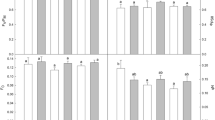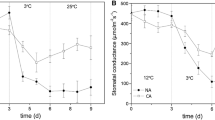Abstract
The effects of chilling (CT, day/night temperatures of 12/10 °C, an irradiance of 250 μmol m−2 s−1), chilling combined with a low irradiance (CL, 12/10 °C, 80 μmol m−2 s−1), and a high temperature (HT, 42/40 °C, 250 μmol m−2 s−1) on chlorophyll content, chlorophyll fluorescence, and gas exchange were studied in two watermelon cultivars, ZJ8424 and YS01, differing in their resistance. The chlorophyll content, net photosynthetic rate (PN), stomatal conductance (gs), and transpiration rate (E) decreased substantially, whereas the intercellular CO2 concentration (ci) increased when the two watermelon cultivars were grown under these stresses. The photosynthetic parameters showed greater changes at chilling than at the high temperature, and the CL caused a more pronounced inhibition in PN compared with the CT. After 2 d exposure to the CT, YS01 had higher PN, gs, and E, but a lower ci compared with ZJ8424. The maximum efficiency of photosystem (PS) II photochemistry (Fv/Fm), effective quantum yield of PS II photochemistry (ΦPSII), photochemical quenching (qP), and electron transport rate (ETR) decreased under the CT and CL but showed only a slight drop under the HT. All these stresses significantly increased non-photochemical quenching (NPQ). The CT brought more damage to the photosynthetic apparatus of leaves compared with the CL. In addition, after returning to normal conditions (25/15 °C, 250 μmol m−2 s−1) for 3 d, the photosynthetic parameters recovered to pre-stress levels in HT treated seedlings but not in CT treated seedlings. In conclusion, the low irradiance could help to alleviate the extent of photoinhibition of PS II photochemistry caused by chilling and cv. ZJ8424 was more sensitive to the extreme temperatures than cv. YS01.
Similar content being viewed by others
Abbreviations
- ci :
-
intercellular CO2 concentration
- CL:
-
chilling at low irradiance
- CT:
-
chilling at normal irradiance
- E:
-
transpiration rate
- ETR:
-
electron transport rate
- F0 :
-
minimal fluorescence
- Fv/Fm :
-
maximum efficiency of PS II photochemistry
- gs :
-
stomatal conductance
- HT:
-
high temperature
- NPQ:
-
non-photochemical quenching
- PS:
-
photosystem
- qP:
-
photochemical quenching
- PN :
-
net photosynthetic rate
- SE:
-
standard error
- ΦPSII :
-
effective quantum yield of PS II photochemistry
References
Allen, D.J., Ort, D.R.: Impacts of chilling temperatures on photosynthesis in warm-climate plants. — Trends Plant Sci. 6: 36–42, 2001.
Allakhverdiev, S.I., Kreslavski, V.D., Klimov, V.V., Los, D.A., Carpentier, R., Mohanty, P.: Heat stress: an overview of molecular responses in photosynthesis. — Photosynth. Res. 98: 541–550, 2008.
Aro, E.M., Virgin, I., Andersson, B.: Photoinhibition of photosystem II. Inactivation, protein damage and turnover. — Biochem. biophys. Acta 1143: 113–134, 1993.
Berry, J., Björkman, O.: Photosynthetic response and adaptation to temperature in higher plants. — Annu. Rev. Plant Physiol. 31: 491–543, 1980.
Dat, J., Vandenabeele, S., Vranová, E., Montagu, M.V., Inzé, D., Breusegem, V.: Dual action of the active oxygen species during plant stress responses. — Cells Mol. Life Sci. 57: 779–795, 2000.
Demmig-Adams, B., Adams III, W.W.: Photoprotection and other responses of plants to high light stress. — Annu. Rev. Plant Biol. 43: 599–626, 1992.
Djanaguiraman, M., Prasad, P.V.V., Boyle, D.L., Schapaugh, W.T.: High temperature stress and soybean leaves: leaf anatomy and photosynthesis. — Crop Sci. 51: 2125–2131, 2011.
Djanaguiraman, M., Prasad, P.V.V., Seppanen, M.: Selenium protects sorghum leaves from oxidative damage under high temperature stress by enhancing antioxidant defense system. — Plant Physiol Biochem. 48: 999–1007, 2010.
Du, Y.C., Nose, A., Wasano, K.: Effects of chilling temperature on photosynthetic rates, photosynthetic enzyme activities and metabolite levels in leaves of three sugarcane species. — Plant Cell Environ. 22: 317–324, 1999.
Filella, I., Serrano, L., Serra, J., Penuelas, J.: Evaluating wheat nitrogen status with canopy reflectance indices and discriminant analysis. — Crop Sci. 35: 1400–1405, 1995.
Genty, B., Briantais, J.M., Baker, N.R.: The relationship between the quantum yield of photosynthetic electron transport and quenching of chlorophyll fluorescence. — Biochem. biophys. Acta 990: 87–92, 1989.
Gitelson, A.A., Merzlyak, M.N.: Relationships between leaf chlorophyll content and spectral reflectance and algorithms for non-destructive chlorophyll assessment in higher plant leaves. — J Plant Physiol. 160: 271–282, 2003.
Greer, D.H., Berry, J.A., Björkman, O.: Photoinhibition of photosynthesis in intact bean leaves: role of light and temperature, and requirement for chloroplast-protein synthesis during recovery. — Planta 168: 253–260, 1986.
Groom, Q.J., Baker, N.R.: Analysis of light-induced depressions of photosynthesis in leaves of a wheat crop during the winter. — Plant Physiol. 100: 1217–1223, 1992.
Hou, W., Sun, A.H., Yang, F.S., Zhan, Y.F., Li, S.Z., Zhou, Z.D.: Effects of low temperature stress on photosynthesis and chlorophyll fluorescence in watermelon seedlings. — Guang Dong Agr. Sci. 13: 35–39, 2014.
Huner, N., Öquist, G., Sarhan, F.: Energy balance and acclimation to light and cold. — Trends Plant Sci. 3: 224–230, 1998.
Krause, G.H., Weis, E.: Chlorophyll fluorescence and photosynthesis: the basics. — Annu. Rev. Plant Biol. 42: 313–349, 1991.
Kratsch, H.A., Wise, R.R.: The ultrastructure of chilling stress. — Plant Cell Environ. 23: 337–350, 2000.
Kudoh, H., Sonoike, K.: Irreversible damage to photosystem I by chilling in the light: cause of the degradation of chlorophyll after returning to normal growth temperature. — Planta 215: 541–548, 2002.
Martin, B., Ort, D.R., Boyer, J.S.: Impairment of photosynthesis by chilling-temperatures in tomato. — Plant Physiol. 68: 329–334, 1981.
Matta, D.F.M., Maestri, M.: Photoinhibition and recovery of photosynthesis in Coffea arabica and C. canephora. — Photosynthetica 34: 439–446, 1998.
Murata, N., Takahashi, S., Nishiyama, Y., Allakhverdiev, S.I.: Photoinhibition of photosystem II under environmental stress. — Biochem. biophys. Acta 1767: 414–421, 2007.
Oquist, G., Hurry, V.M., Huner, N.P.A.: Low-temperature effects on photosynthesis and correlation with freezing tolerance in spring and winter cultivars of wheat and rye. — Plant Physiol. 101: 245–250, 1993.
Pastenes, C., Horton, P.: Effect of high temperature on photosynthesis in beans. II. CO2 assimilation and metabolite contents. — Plant Physiol. 112: 1253–1260, 1996.
Ploschuk, E.L., Bado, L.A., Salinas, M., Wassner, D.F., Windauer, L.B., Insausti, P.: Photosynthesis and fluorescence responses of Jatropha curcas to chilling and freezing stress during early vegetative stages. — Environ. exp. Bot. 102: 18–26, 2014.
Powles, S.B.: Photoinhibition of photosynthesis induced by visible light. — Annu. Rev. Plant Physiol. 35: 15–44, 1984.
Ruelland, E., Zachowski, A.: How plants sense temperature. — Environ. exp. Bot. 69: 225–232, 2010.
Sonoike, K.: Various aspects of inhibition of photosynthesis under light/chilling stress: “photoinhibition at chilling temperatures” versus “chilling damage in the light”. — J. Plant Res. 111: 121–129, 1998.
Sharkey, T.D.: Effects of moderate heat stress on photosynthesis: importance of thylakoid reactions, rubisco deactivation, reactive oxygen species, and thermotolerance provided by isoprene. — Plant Cell Environ. 28: 269–277, 2005.
Taylor, A.O., Rowley, J.A.: Plants under climatic stress I. Low temperature, high light effects on photosynthesis. — Plant Physiol. 47: 713–718, 1971.
Wang, L.J., Sun, Y.P., Zhang, Z.P., Kang, L.: Effects of 5- aminolevulinic acid (ALA) on photosynthesis and chlorophyll fluorescence of watermelon seedlings grown under low light and low temperature conditions. — Acta Hort. 856: 159–166, 2010.
Wise, R.R., Olson, A.J., Schrader S M., Sharkey, T.D.: Electron transport is the functional limitation of photosynthesis in fieldgrown pima cotton plants at high temperature. — Plant Cell Environ. 27: 717–724, 2004.
Yamori, W., Noguchi, K., Kashino, Y., Terashima, I.: The role of electron transport in determining the temperature dependence of the photosynthetic rate in spinach leaves grown at contrasting temperatures. — Plant Cell Physiol. 49: 583–591, 2008.
Yan, N., Xu, X.F., Wang, Z.D., Huang, J.Z., Guo, D.P.: Interactive effects of temperature and light intensity on photosynthesis and antioxidant enzyme activity in Zizania latifolia Turcz. plants. — Photosynthetica 51: 127–138, 2013.
Zinn, K.E., Tunc-Ozdemir, M., Harper, J.F.: Temperature stress and plant sexual reproduction: uncovering the weakest links. — J. exp. Bot. 61: 1959–1968, 2010.
Author information
Authors and Affiliations
Corresponding author
Additional information
Acknowledgements: This work was supported by the Agriculture Research in the Public Interest of China under Grant numbers (GYHY20120619) and by the excellent thesis project in Hainan University.
Rights and permissions
About this article
Cite this article
Hou, W., Sun, A.H., Chen, H.L. et al. Effects of chilling and high temperatures on photosynthesis and chlorophyll fluorescence in leaves of watermelon seedlings. Biol Plant 60, 148–154 (2016). https://doi.org/10.1007/s10535-015-0575-1
Received:
Revised:
Accepted:
Published:
Issue Date:
DOI: https://doi.org/10.1007/s10535-015-0575-1




